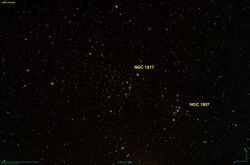Astronomy:NGC 1817
| NGC 1817 | |
|---|---|
 NGC 1817 as seen by the DSS | |
| Observation data (J2000 epoch) | |
| Constellation | Taurus |
| Right ascension | 05h 12m 15.(0)s[1] |
| Declination | +16° 41′ 2(4)″[1] |
| Distance | 6,430 ly (1,972 pc)[2] |
| Apparent magnitude (V) | 7.7[3] |
| Apparent dimensions (V) | 9.3′[3] |
| Physical characteristics | |
| Estimated age | 0.8−1.2[4] Gyr |
| Other designations | C 0509+166, Collinder 60 |
NGC 1817 is an open cluster of stars in the constellation Taurus. It was discovered by English astronomer William Herschel in February 1784.[5] With an apparent magnitude of 7.7[3] and spanning 9.3 arc minutes across the sky, it is separated from the NGC 1807 cluster by just 26 arc minutes.[6][circular reference] Indeed, the two may actually be parts of a single extended cluster.[5]
The NGC 1817 cluster is around the same age as the Hyades, or perhaps a little younger at 0.8−1.2 billion years. The turnoff point for this cluster—where stars above a certain mass are evolving through the red giant stage—is twice the mass of the Sun.[7] The cluster is situated in the opposite side of the sky from the Galactic Center at a separation of 32 kly (9.9 kpc) from the core,[7] and is around 1.3 kly (0.4 kpc) away from the Galactic plane.[4]
Measurements of the proper motion of 810 stars within a 1.5° region centered on the cluster suggest that it has at least 169 members.[8] Of these, there is a total of 26 variable stars, including three candidate Gamma Doradus variable stars and sixteen Delta Scuti variables.[9] This unusually high proportion of Delta Scuti variables is likely the result of the turnoff point being located within the instability strip.[5]
Gallery
References
- ↑ 1.0 1.1 Wu, Zhen-Yu et al. (November 2009), "The orbits of open clusters in the Galaxy", Monthly Notices of the Royal Astronomical Society 399 (4): 2146–2164, doi:10.1111/j.1365-2966.2009.15416.x, Bibcode: 2009MNRAS.399.2146W.
- ↑ Kharchenko, N. V. et al. (August 2005). "Astrophysical parameters of Galactic open clusters". Astronomy and Astrophysics 438 (3): 1163–1173. doi:10.1051/0004-6361:20042523. Bibcode: 2005A&A...438.1163K.
- ↑ 3.0 3.1 3.2 "The Sky Live - NGC 1817 - Open Cluster in Taurus". https://theskylive.com/sky/deepsky/ngc1817-object.
- ↑ 4.0 4.1 Donati, P. et al. (January 2014), "NGC 1817, NGC 2141 and Berkeley 81: three BOCCE clusters of intermediate age", Monthly Notices of the Royal Astronomical Society 437 (2): 1241–1258, doi:10.1093/mnras/stt1944, Bibcode: 2014MNRAS.437.1241D.
- ↑ 5.0 5.1 5.2 O'Meara, Stephen James (2011), Deep-Sky Companions: The Secret Deep, 4, Cambridge University Press, p. 84, ISBN 978-1139500074, https://books.google.com/books?id=v859bKO0A4gC&pg=PA94.
- ↑ "NGC 1807 and 1817 separation". https://en.wikipedia.org/wiki/File:NGC_1807_and_NGC_1817_separation.jpg.
- ↑ 7.0 7.1 Reddy, Arumalla B. S. et al. (January 2012), "Comprehensive abundance analysis of red giants in the open clusters NGC 752, 1817, 2360 and 2506", Monthly Notices of the Royal Astronomical Society 419 (2): 1350–1361, doi:10.1111/j.1365-2966.2011.19791.x, Bibcode: 2012MNRAS.419.1350R.
- ↑ Balaguer-Núñez, L.; Jordi, C.; Galadí-Enríquez, D.; Zhao, J. L. (November 2004), "New membership determination and proper motions of NGC 1817. Parametric and non-parametric approach", Astronomy and Astrophysics 426 (3): 819–826, doi:10.1051/0004-6361:20041332, Bibcode: 2004A&A...426..819B.
- ↑ Andersen, M. F. et al. (July 2009), "NGC 1817: the richest population of delta Scuti stars", Communications in Asteroseismology 160: 9, doi:10.1553/cia160s9, Bibcode: 2009CoAst.160....9A.
External links
 |


